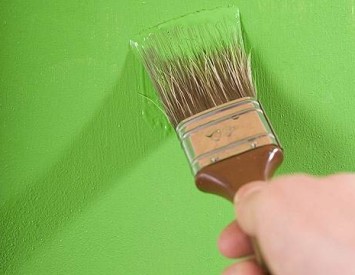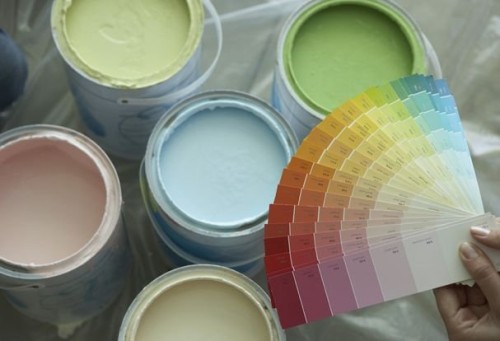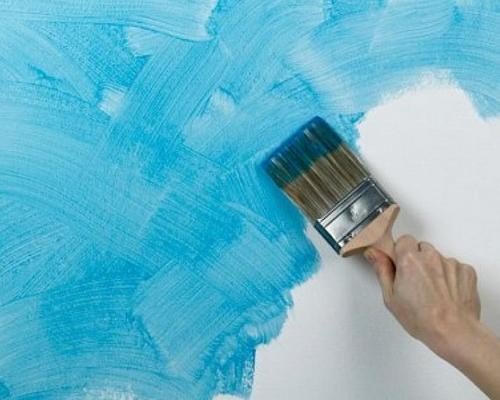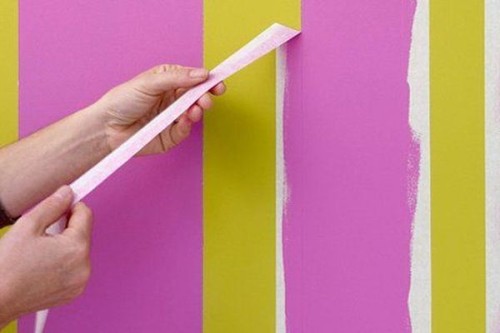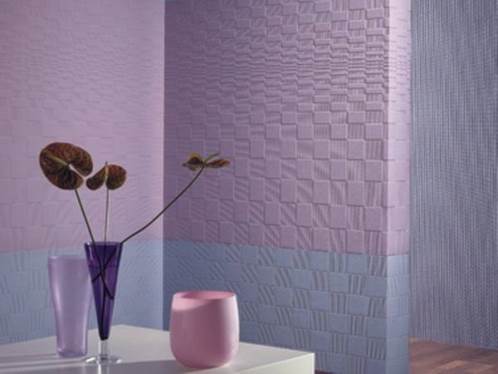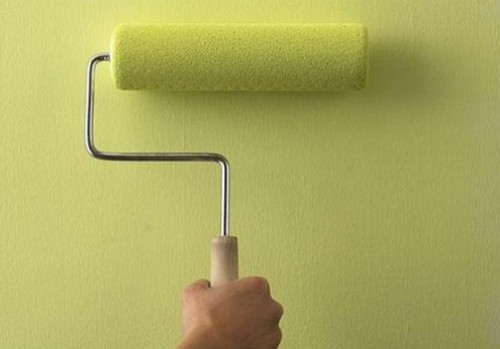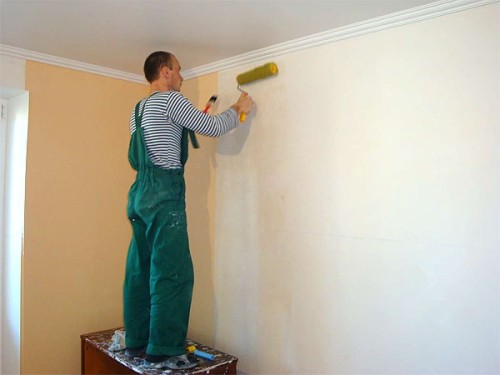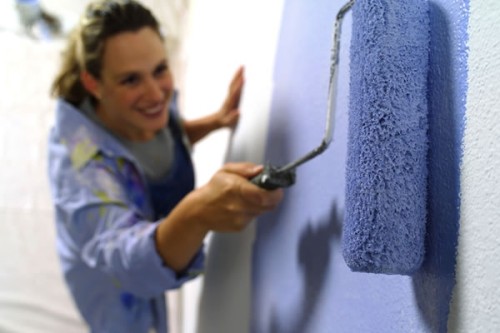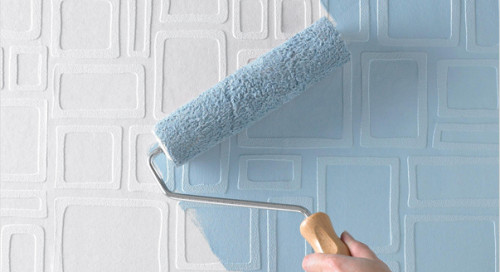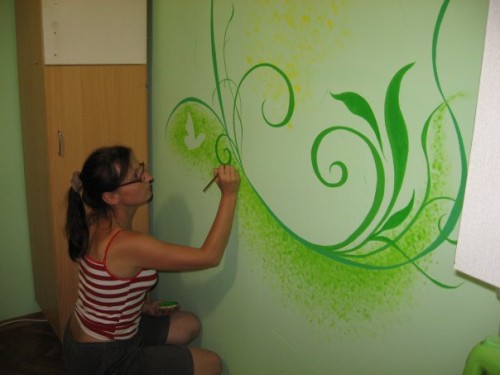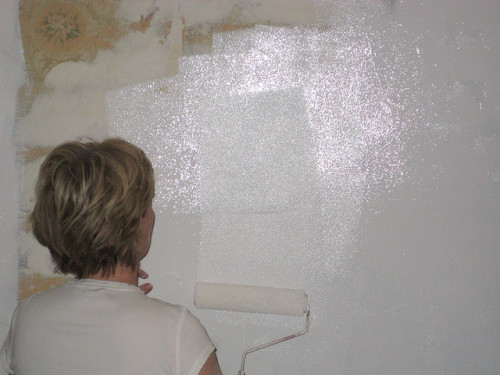Previously, in order to update the interior, I had to buy wallpapers of the color and shade that the manufacturer offered. Today you can purchase special canvases, which subsequently can be painted in any desired color. The interior of any room due to this will sparkle with new bright colors. We will tell you about how to choose and apply paint for painting wallpaper.
Content
Paint for painting for painting
For each type of wallpaper, a certain type of paint is selected. It differs both in quality characteristics and composition. As you know, there are several types of paintings for painting, among them:
- Non -woven.
- Glass wallpaper.
- Paper wallpaper.
For each of them, your own paintwork should be used. Typically, manufacturers produce various types of paint for painting wallpaper, the colors and composition of which are suitable for painting this or that type of canvases.
Consider the main types of material:
- Acrylic paint. The most common species. This is a paint for painting non -woven wallpaper. She is not afraid of moisture and ultraviolet radiation. Therefore, the wallpaper, painted with such a mixture, practically does not burn out. Usually it is applied to the outer surface of the paintings. After painting, all excess material should be removed. This type of paint can be applied directly to the wall before gluing wallpaper. After that, transparent wallpaper on a non -woven basis are glued to the wall. After the material dries, thanks to the transparent structure, the color of the paint will be shone through the canvases, so that the wallpaper will acquire a soft and even shade. If you want to simplify the cleaning in the room as much as possible, you need to give preference to waterproof colors, so that the wallpaper painted with such a mixture can be washed with a damp sponge.
- Painting of wallpaper water -based paint. Such mixtures have a rich palette of color shades. Suitable for painting wallpaper based on fiberglass. In this case, a roller with a soft pile is used to apply the material to the canvases. It is worth noting that this type of paints and varnishes is washed off with water. This should be taken into account during the cleaning of the room.
- Painting wallpaper with latex paint. These mixtures are also called water-dispersion. They are quite environmentally friendly and safe. However, it is worth remembering that after the opening of the package, such a paint thickens quite quickly, so it must be applied immediately to the canvases. Wallpaper, painted with a mixture of this type, will dry no earlier than after 2-3 days.
- Alkyd paints. Used for staining glass wallpaper. A rather dense film forms on the surface of the canvas, which protects the wallpaper from the effects of moisture. Therefore, they can continue to be washed by any detergent. However, it is worth saying about some disadvantages of this type of mixtures. They do not pass air, that is, they “do not breathe”, and also contain some toxic substances in their composition.
Mixture advice
Above, we examined what types of colors are. Now let's talk more about some features of their choice:
- For wallpaper on a non -woven basis, it is better to use any waterproof paint. In the production of such wallpaper, high -quality cellulose is used, which is processed according to special methods.
- For vinyl -based canvases, it is recommended to use latex paints. These wallpaper can similarly can be painted both from the inner and outside.
- For paper -based wallpaper, absolutely any paints are suitable, both acrylic and water -based. The mixture in this case, in order to avoid the appearance of divorces, is applied with a roller with a soft pile.
- Liquid wallpaper is not subject to staining. However, they can be given an additional saturated shade by mixing the components of the material itself with paint of any type. You can also apply a layer of paint directly to the wall, where the decorative mixture of liquid wallpaper will be applied then. In such cases, oil compositions or nitroemal are used.
Many are interested in the question - what is the consumption of paint when painting wallpaper? So, on average for staining 1 sq. m. surfaces will require about 230 grams of the mixture. More precisely, the calculation can be done if you take into account the recommendations for the spray consumption indicated on the packaging of the product.
Let us dwell on the color palette of colors. So, water -based mixtures basically have different shades of color, and dispersion paints are most often produced purely white. In order to get the desired color, it is necessary to hair. Thus, you can get absolutely any shade, for example, “under gold”, “under silver”, “under bronze” or others. Most often, tinting is required when painting old wallpaper paint.
There are several ways to give the paint the desired shade:
- Home tinting. In this case, you should buy a special coloring pigment in the building materials store. It mixes with paint. The result is a paint of the desired color. However, there are several nuances. So, the color of the mixture before applying and after drying can differ significantly. In addition, if the paint is divorced in several portions, it will be difficult to get the same shade in each of them.
- Tinting using special software. In this case, you will need to use a special tinting machine. Thanks to this method, you can get the same shade of paint in all banks.
The process of painting wallpaper
To do this, we need the following tools:
- A roller with a soft pile.
- Capacity for breeding paint.
- Brush 60-70 mm.
- Paper tape.
- You can use a spray gun.
Advice! It is important to choose the right thing for painting wallpaper not only paint, but also a tool for its application. So, it is recommended to use a roller with a long or medium pile. Long villi will be able to paint any texture of wallpaper well, even with ornaments. In no case do not purchase ordinary foam rollers for staining. They greatly reduce the quality of staining surfaces. For staining hard -to -reach places and angles, it is recommended to purchase brushes.
The order of work:
- The first step is the surface preparation. So, you should cover the floors, cover window sills, furniture, radiators with a film. The surface should be cleaned of dust.
- The skirting boards are glued with paper tape. The paint does not flow under it when stained. When the mixture dries, tape is removed.
- Recall that it is important to choose the right paint for painting paintings, depending on which type of wallpaper is glued on the wall. Next, dilute the mixture, as indicated on the package. Sometimes manufacturers recommend adding water to the paint, but not more than 8-10%. In this case, the paint is then mixed well with a mixer to get a good uniform color, without lumps and clots.
- The surface of the surface takes place taking into account all the recommendations from the manufacturer indicated on the packaging of the product. It is important to remember that low-quality cheap mixtures should be applied to 2-3 layers. Thus, it will turn out a persistent and plain color. Before applying the second and third layer, you need to wait until the first dries well. High -quality expensive mixtures are allowed to apply in one layer.
- Initially, the lower and upper parts of the walls are stained with a brush. Make sure that the strokes of the paint are not overlapped, since in this case we will not be able to get a homogeneous shade of the surface. In addition, it is important that the paint does not accumulate at the joints of the wallpaper, otherwise the color will be much darker in these zones.
- Next, you should paint the surface with a roller. Movements should be made in one direction. Then, with a brush, inaccessible places are painted, for example, the zones around the outlet or doorways.
- Then you need to change the roller or just change the pile for a new one. The tool is wetted in water. This must be done in order to crumble a pile that is not attached tightly. Next, we lower the roller into the container with the paint and roll it well until it is completely saturated with the coloring mixture.
- Next, we stain the wall on which the wallpaper is glued, the second layer. It is important to achieve uniform staining of the surface. Keep in mind that the second layer of paint is applied only after the first is completely dry.
- Apply the coloring composition to the wall, glued with wallpaper, you can vertical even stripes from floor to ceiling. It is important that these stripes are strictly parallel. The width of each can be 650-750 mm. It is necessary to paint with quick and accurate movements.
- Next, remove the excess paint. We filter the roller through the nylon stocking and rinse it. That's all, work on painting the wallpaper can be considered complete.
Pay attention when carrying out work for some points:
- In order to give the interior a special zest, painting the wallpaper of pearl paint is used. Such a mixture can be painted both the entire wall and a separate zone.
- For structural wallpaper, a dispersion mixture is suitable. The color of such paintings occurs using a wide roller. The mixture is rolled over the surface of the wall. In order to emphasize the structure of the wallpaper, a structural roller with a pile of medium length is used.
- To get an interesting shade of non -woven wallpaper, try to paint them in two layers. Moreover, apply the second layer with a paint of another shade.
- As mentioned above, if you want to get an unusual shade of wallpaper on a non -woven basis, then the paint must be applied to their inside or on the wall. As a result, you can get a persistent, uniform shade.
Painting for wallpapers for painting: photo
